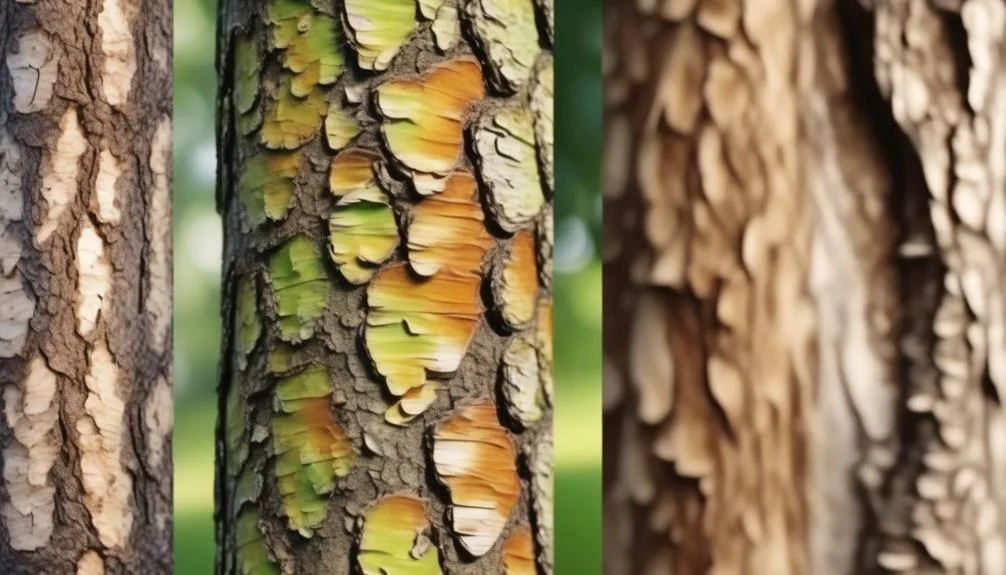Spotting diseases in elm tree bark can be crucial for their well-being. The patterns and discolorations on the bark can indicate potential issues. Learning to recognize these signs can help protect these majestic trees.
Understanding elm tree bark diseases is essential for maintaining their health. Stay tuned to discover how to identify and address potential diseases, ensuring the longevity of these beautiful trees in your surroundings.
Signs of Elm Tree Bark Diseases
Identifying signs of Elm tree bark diseases is crucial for maintaining the health and vitality of your trees.
Prevention methods and treatment options play a significant role in managing these diseases.
One of the key signs of Elm tree bark diseases is the presence of raised or sunken areas on the bark, often accompanied by discoloration.
Additionally, you may notice wilting leaves, dieback of branches, and unusual growths on the tree.
These diseases can have a severe impact on tree health, leading to reduced growth and overall decline, which in turn can have ecosystem implications.
It's essential to monitor your Elm trees regularly and promptly address any signs of bark diseases.
Consulting with a professional arborist can provide valuable guidance on the best prevention and treatment strategies.
Common Elm Tree Bark Diseases
Elm trees are susceptible to various bark diseases, which can significantly impact their health and longevity. Common elm tree bark diseases include:
- Elm tree bark discoloration: Look for patches of discoloration, such as dark brown or black spots, which may indicate the presence of fungal infections like Dutch elm disease.
- Elm tree bark texture abnormalities: Check for rough, cracked, or peeling bark, as these abnormalities can be a sign of diseases such as elm bark beetle infestation or phloem necrosis.
Inspecting the bark regularly and being vigilant for these signs can help in early detection and treatment of common elm tree bark diseases, thus preserving the health and beauty of your elm trees.
Identifying Fungal Infections on Elm Trees
When inspecting elm trees for fungal infections, carefully examine the bark for patches of discoloration, such as dark brown or black spots, which may indicate the presence of diseases like Dutch elm disease.
Prevention is key, and one way to prevent fungal infections on elm trees is by maintaining proper tree health through regular watering, pruning, and fertilization. Additionally, ensuring good air circulation around the tree can help prevent fungal growth.
If you notice any signs of fungal infection, such as cankers, wilting, or unusual leaf discoloration, it's important to act promptly to prevent the spread of the disease.
Recognizing Bacterial Infections on Elm Trees
To recognize bacterial infections on elm trees, closely examine the bark for oozing, sunken areas, or cankers that may indicate the presence of diseases such as bacterial leaf scorch or elm yellows. These symptoms are crucial in identifying bacterial infections early on, allowing for prompt treatment.
Here's what to look for:
- Leaf Symptoms: Keep an eye out for yellowing or browning leaves that wilt and die prematurely, often starting at the outer edges.
- Vascular Discoloration: Look for dark streaks in the sapwood under the bark, which is a common symptom of bacterial infections.
- Treatment Options: Once bacterial infections are identified, it's important to promptly prune and destroy infected branches and to ensure proper watering and fertilization to maintain tree vigor. Consider consulting with a professional arborist for further treatment options.
Steps to Diagnose Elm Tree Bark Diseases
After recognizing the symptoms of bacterial infections on elm trees, the next step is to learn the steps to diagnose elm tree bark diseases for effective treatment and management.
Diagnosing techniques involve closely examining the bark for discoloration, which can indicate various diseases such as Dutch elm disease or phloem necrosis. Look for areas of the bark that appear discolored, such as yellowing, browning, or black lesions. Additionally, assess the bark texture, feeling for any unusual softness, roughness, or peeling.
Environmental factors should also be considered, such as recent weather patterns, soil conditions, and nearby tree health. Taking note of these factors can help in accurately identifying the specific disease affecting the elm tree's bark, allowing for targeted treatment and preventive measures.
Conclusion
In summary, being vigilant for signs of Dutch Elm Disease and Elm Bark Beetle infestation is crucial for protecting your Elm trees.
Prompt action and consultation with a professional arborist can help mitigate potential damage and preserve the health of your trees.
Stay proactive in monitoring your Elm trees to ensure their well-being.

My interest in trees started when I first saw the giant sequoias in Yosemite.
I was a teenager then, and I remember thinking, “I need to learn more about this.”
That moment stuck with me.
A few years later, I went on to study forestry at Michigan Tech.
Since graduating, I’ve worked in a mix of hands-on tree care and community education.
I’ve spent over ten years helping people understand how to plant, maintain, and protect the trees in their neighborhoods.
I don’t see trees as just part of the landscape.
They are living things that make a real difference in our daily lives.
